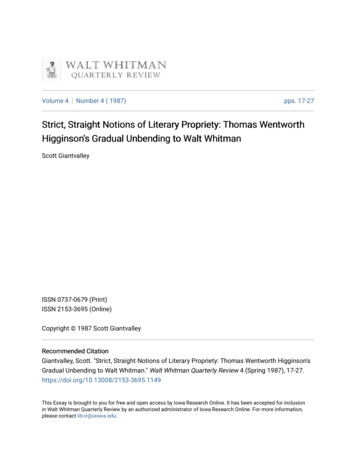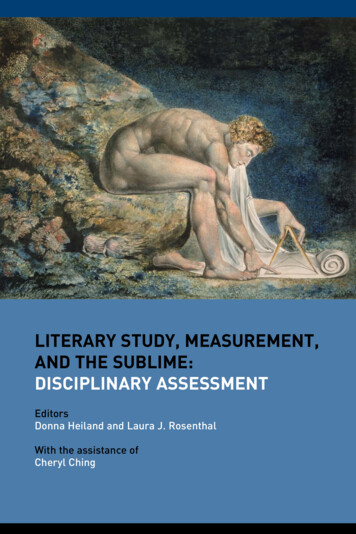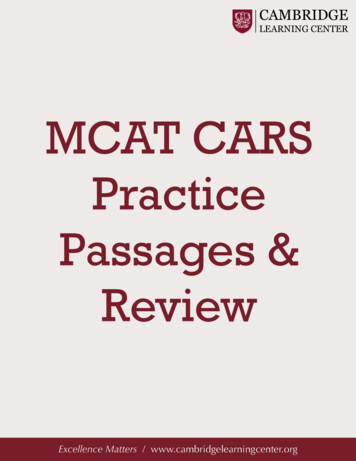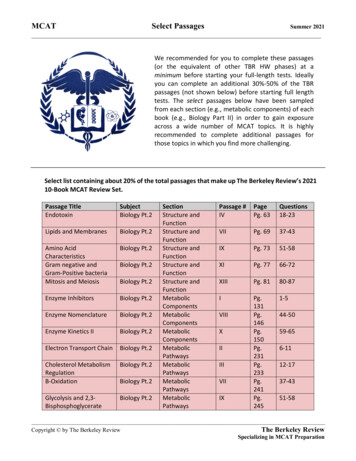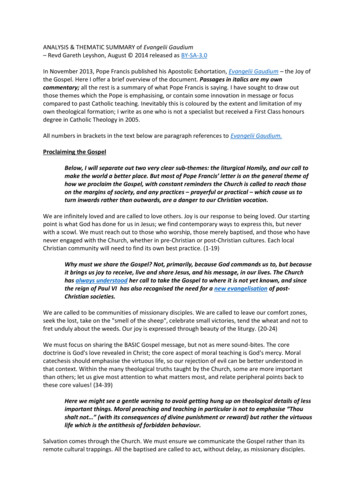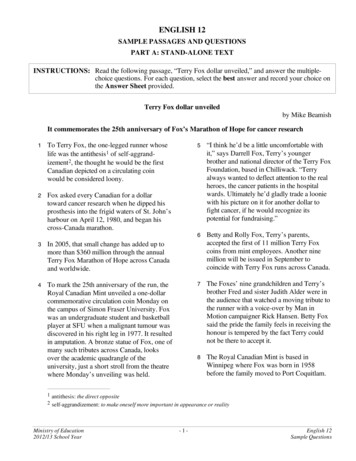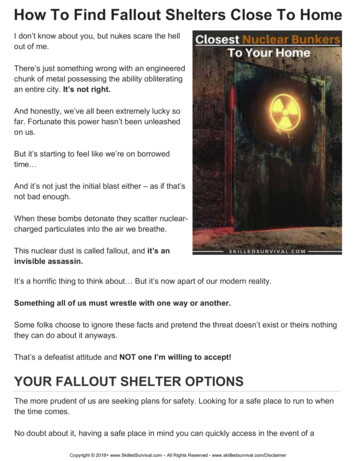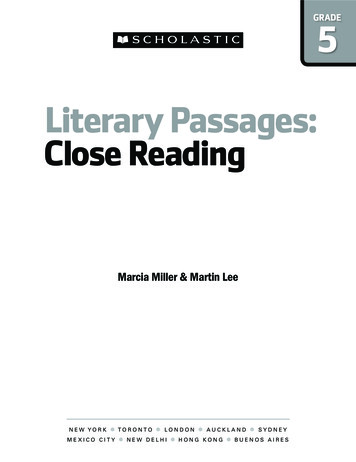
Transcription
GRADE5Literary Passages:Close ReadingMarcia Miller & Martin LeeNEW YORK MEXICO CITYTORONTO LONDONNEW DELHI AUCKLANDHONG KONG SYDNEYBUENOS AIRES
Scholastic Inc. grants teachers permission to photocopy the reproducible pages from this book for classroom use. No other part of thispublication may be reproduced in whole or in part, or stored in a retrieval system, or transmitted in any form or by any means, electronic,mechanical, photocopying, recording, or otherwise, without written permission of the publisher. For information regarding permission,write to Scholastic Inc., 557 Broadway, New York, NY 10012.Cover design: Tannaz FassihiCover illustration: Patrick GeorgeInterior design: Kathy MassaroInterior illustrations by Doug Jones, Kelly Kennedy, Michael Moran, and Jason RobinsonISBN: 978-0-545-79388-9Copyright 2016 by Scholastic Inc.All rights reserved.Printed in the U.S.A.Published by Scholastic Inc.First printing, January 2016.12345678910402322212019181716
ContentsIntroduction.5Teaching Routine for Close Reading and Purposeful Text Marking.7Connections to the Standards.9Comprehension Skill Summary Cards.10Literary Text PassagesCharacter1. Fishing With Grandpa Leon (890 L). Realistic Fiction.142. A Cabin in Syracuse, 1855 (990 L). Historical Fiction.16Point of View3. The Expedition (880 L). Adventure Story.184. The Record Setter (960 L). Humorous Story.20Setting/Mood5. The Beach House (850 L). Suspense Story.226. Mile-and-a-Quarter Monkey (960 L). Descriptive Story.24Key Events & Details7. Medieval Festival (920 L). Fantasy.268. Block Party Celebrity (1000 L). Community Story.28Literary Passages: Close Reading (Grade 5) Scholastic Inc.
Sequence of Events9. Painted Sneakers (970 L). Crafts Story.3010. The Relief Pitcher (1010 L). Sports Story.32Conflict & Resolution11. Krishna’s Lesson (860 L). Legend.3412. Talent Show Contest (910 L). Entertainment Story.36Context Clues13. The Unlucky Lizard (870 L). Folktale.3814. The Shipwreck (880 L). Fable.40Compare & Contrast15. Room and Bored (850 L). Family Story.4216. The Chapman Stick (860 L). Music Story.44Make Inferences17. Have You Ever Seen? (N/A). Poem.4618. To Go or Not to Go (1010 L). Science Fiction Story.48Summarize19. Egg of Chaos (830 L). Creation Myth.5020. Febold Feboldson’s Find (980 L). Tall Tale.52Answer Key.54Literary Passages: Close Reading (Grade 5) Scholastic Inc.
IntroductionReading, discussing, and sharing literary texts contributes greatly to thedevelopment of well-rounded minds. Exposure to diverse forms, characters,and plots set in varied time periods and cultures models for readers how the worldworks. Literary texts help us learn how people explore, interact, struggle, grow,and solve problems. In short, reading fiction enriches us!Modern science supports that the human brain is hard-wired forstories. All cultures immerse their children in stories that explain theConnections toways of the world while engaging their emotions. Although manythe Standardsstudents enjoy reading fiction, navigating the wide variety of richThe chart on page 9literary texts poses challenges for evolving readers. Students may lackdetails how thesufficient vocabulary or background knowledge to follow along. Somelessons in thisliterary forms or features may be puzzling at first. This is why exposingbook will help yourstudents more frequently to complex literary texts and introducingstudents meetthem to active reading-comprehension strategies are now keythe more rigorouscomponents of successful reading instruction. Useful strategies, clearlydemands of today’staught, can empower readers to approach literary texts purposefully,reading standardsfor literature.closely, and independently. Such active tools provide students with afoundation for success not only in school, but for the rest of their lives.Text Marking: A Powerful Active-Reading StrategyTo improve their comprehension of complex literary texts, students mustactively engage with the material. Careful and consistent text marking by hand isone valuable way to accomplish this. To begin with, by numbering paragraphs,students can readily identify the location of useful narrative details whendiscussing a piece. By circling main characters, underlining pertinent clues tosetting or sequence, and boxing key vocabulary, students interact directly with thematerial, making it more digestible in the process. But the true goal of teachingtext marking is to help students internalize an effective close-reading strategy, notto have them show how many marks they can make on a page.Purposeful text marking intensifies readers’ focus. It helps them identifynarrative elements as they read and recognize and isolate key details or connectrelevant ideas presented in the text. For instance, boxing words like first, then, next,and finally can clarify the sequence of ideas or events in a passage. By underliningexpressions like the trouble is or one answer is, students learn to identify conflictsand their resolutions. When students are asked to compare and contrast elementsin a passage, boxing signal words and phrases, such as both, but, or however, canmake identifying similarities and differences more apparent. Words like since,because, and as a result signal cause-and-effect relationships that structure a piece.Furthermore, the physical act of writing by hand, in itself, helps students not onlyprocess what they read, but remember it as well.5Literary Passages: Close Reading (Grade 5) Scholastic Inc.
About the PassagesThe 20 reproducible passages in this book, which vary by genre, form, purpose, tone,and task, address ten key reading-comprehension skills, from identifying character, pointof view, setting, and key events and details, to sequencing, making inferences, and usingcontext clues to unlock the meaning of unfamiliar words or phrases. Consult the Tableof Contents to see the scope of skills, genres, forms, and Lexile scores of the passages.The Lexile scores fall within the ranges recommended for fifth graders. (The scores forgrade 5, revised to reflect the more rigorous demands of today’s higher standards, rangefrom 830 to 1010. This range addresses the variety commonly seenin typical fifth grade classrooms.) Note: The poem on page 46 does notinclude a Lexile score because poetry is excluded from Lexile measurements.Each passage appears on its own page, beginning with the title,the genre or form of the passage, and the main comprehension skillthe passage addresses. All passages include illustrations. Some includecommon text elements, such as capital letters used for emphasisand captions.The passages are stand-alone texts that can be used in any order youchoose. Feel free to assign passages to individuals, pairs, small groups,or the entire class, as best suits your teaching style. However, it’s a goodidea to preview each passage before you assign it to ensure that yourstudents have the skills needed to complete it successfully. (See the nextpage for a close-reading routine to model for students.)4Point of ViewNameDateThe Record SetterRead the humorous story.Then follow the directions in the Text Marking box.My brother, Alex, is generally considered to bea reliable, clever, thoughtful fellow. I say “generally”because of things like what he’s doing right now.Picture this and you’ll understand. While I, Nate,sit here playing a video game and texting with half myfriends—two perfectly normal things to be doing foramusement—what is he occupied with? Alex is standingover there, counting softly to himself 79, 80, 81, 82. . .while he repeatedly bats a rubber ball attached by anText Markingelastic string to a wooden paddle. This is nonsensicalbehavior, is it not?You might think I’m being too hard on Alex, asIdentify the main characterin this story. Read for cluesabout point of view.brothers sometimes can be to one another. On theBox signal wordscontrary, I’m being lenient. You see, this time it’s paddle-that suggest who tellsball batting, but the last time—and I refer to just a fewthe story.weeks ago—the challenge was standing on his head forhow the story is told.as long as he could, with a timer set up on the rug.first personOf course, he had to read it upside down, but I supposethird personhe got better at it day by day. Maybe he should’ve put thetimer upside down, too.Circle the nameof the main character.Frankly, I’m getting a bit concerned. What if oneof his goofy pals introduces him to alligator wrestling?Underline wordsOr what if he gets enticed to take up tightrope walkingor phrases that describefrom skyscraper to skyscraper? I tell you, for Alex, thesethe main character.ideas are not too far-fetched!Literary Passages: Close Reading (Grade 5) Scholastic Inc.204Reading-Comprehension Question PagesDo MoreNameDateThe Record SetterAnswer each question. Give details from the humorous story.,Following each passage is a reproducible “Do More” page oftext-dependent comprehension questions: two are multiple-choicequestions that call for a single response and a brief, text-basedexplanation to justify that choice. The other two questions are openresponse items. The questions address a range of comprehensionstrategies and skills. All questions share the goal of ensuring thatstudents engage in close reading of the text, grasp its key ideas, andprovide text-based evidence to support their answers. Keep additionalpaper on hand so students have ample space to write complete andthorough answers.1tt¶ A. . . wrestle alligators.tt¶ C. . . . play table tennis.tt¶ B. . . praise his brother.tt¶ D. . . . play video games.What helped you answer?2Which is a synonym for lenient?tt¶ A.easygoingtt¶ B.tt¶ C. lovingcriticaltt¶ D. harshWhat helped you answer?3How does Nate use exaggeration to get across his point about his brother’s behavior?4Imagine Alex describing Nate. How might the story be different?Literary Passages: Close Reading (Grade 5) Scholastic Inc.214Answer KeyTo amuse himself, Nate likes to . . .Point of ViewNameDateThe Record SetterRead the humorous story.Then follow the directions in the Text Marking box.An Answer Key (pages 54–63) includes annotated versions of eachmarked passage and sample answers to its related questions. Maintainflexibility in assessing student responses, as some markings and answersto open-response questions may vary. (Because students are likely to markdifferent places in the text for particular skills, the annotated versionsin the Answer Key highlight a variety of possible responses.) Encouragestudents to self-assess and revise their answers as you review the textmarkings together. This approach encourages discussion, comparison,extension, reinforcement, and correlation to other reading skills.6My brother, Alex, is generally considered to bea reliable, clever, thoughtful fellow. I say “generally”because of things like what he’s doing right now.Picture this and you’ll understand. While I, Nate,sit here playing a video game and texting with half myfriends—two perfectly normal things to be doing foramusement—what is he occupied with? Alex is standingover there, counting softly to himself 79, 80, 81, 82. . .while he repeatedly bats a rubber ball attached by anText Markingelastic string to a wooden paddle. This is nonsensicalbehavior, is it not?You might think I’m being too hard on Alex, asbrothers sometimes can be to one another. On thecontrary, I’m being lenient. You see, this time it’s paddleball batting, but the last time—and I refer to just a fewweeks ago—the challenge was standing on his head foras long as he could, with a timer set up on the rug.Of course, he had to read it upside down, but I supposehe got better at it day by day. Maybe he should’ve put thetimer upside down, too.Identify the main characterin this story. Read for cluesabout point of view.Box signal wordsthat suggest who tellsthe story.how the story is told.first personthird personCircle the nameFrankly, I’m getting a bit concerned. What if oneof his goofy pals introduces him to alligator wrestling?of the main character.Underline wordsOr what if he gets enticed to take up tightrope walkingor phrases that describefrom skyscraper to skyscraper? I tell you, for Alex, thesethe main character.ideas are not too far-fetched!20Literary Passages: Close Reading (Grade 5) Scholastic Inc.Literary Passages: Close Reading (Grade 5) Scholastic Inc.
Teaching Routine for Close Reading and Purposeful Text MarkingAny text can become more accessible to readers who have learned to bring various strategies, suchas purposeful text marking, to the reading process. Here is one suggested routine that may beeffective in your classroom.Previewof the topic of the piece and its genre. Help students link it to similartopics or examples of the genre they may have read.44Engage prior knowledge44Identify the reading skill for which students will be marking the text. Display or distributethe Comprehension Skill Summary Card that applies to the passage. Go over its key ideas.(See Comprehension Skill Summary Cards, pages 8, 10–12, for more.)Model (for the first passage, to familiarize students with the process)using an interactive whiteboard, document camera, or other resource,and provide students with their own copy. Preview the text with students by having them readthe title and look at any illustrations or other graphic elements.44Display the passage44Draw attention to the markings44as students follow along. Guide students to think about the skill andto write any questions they may have on sticky-notes.44Mark the text together.students will use to enhance their understanding of the piece.Link the text marking box to the Comprehension Skill Summary Card for clarification.Read aloud the passageBegin by numbering the paragraphs. Then discuss the choices youmake when marking the text, demonstrating and explaining how the various text elementssupport the skill. Check that students understand how to mark the text using the various iconsand graphics shown in the text marking box.Read44Display the passage for a shared reading experience. Doa quick-read of the passage togetherto familiarize students with it. Then read it together a second time, pausing as necessary toanswer questions, draw connections, or clarify words as needed. Then read the passage oncemore, this time with an eye to the text features described in the text marking box.44Invite students to offer ideas for additional markings. Thesemight include noting unfamiliarvocabulary, an idiom or phrase they may not understand, or an especially interesting, unusual,or important detail they want to remember. Model how to use sticky-notes, colored pencils,highlighters, question marks, or check marks.Respond44Have students read the passage independently. This fourth reading is intended to allowstudents to mark the text themselves. It will also prepare them to discuss the piece and offertheir views about it.44Have students answer the questionson the companion Do More page. Depending on theabilities of your students, you might read aloud the questions to them, and then have themanswer orally. Model how to look back at the text markings and other text evidence forassistance. This will help students provide complete and supported responses.7Literary Passages: Close Reading (Grade 5) Scholastic Inc.
Comprehension Skill Summary CardsTo help students review the ten reading-comprehension skills this book addressesand the specific terms associated with each, have them use the ten reproducibleComprehension Skill Summary Cards (pages 10–12). The boldface terms on each cardare the same ones students will identify as they mark the text.You might duplicate, cut out, and distribute a particular Comprehension SkillSummary Card before assigning a passage that focuses on that skill. Discuss the elementsof the skill together to ensure that students fully grasp it. Encourage students to save andcollect the cards, which they can use as a set of reading aids whenever they read anytype of literary text. Or display the cards in a reading center in your classroom that isavailable at all times.Tips and SuggestionsComprehension SkillComprehenandadaptable.While numbering, boxing,44 The text-marking process is versatilesion SkillSequence of Eventscircling, and underlining are the most common methods,you can personalizeConflict & ResolutionIn most stories, events happthe strategy for your class if it helpstheYoumighthaveenprocess.in acertain oraugmentder or sequenGood stories hace. Some evenve a pltoppenmarkot. The plotstudents use letters or numbershatocan, tsfor example,MCin the betext;is the setginningtheyof keywriteevents that mof the story.Other thingsove the storyhappen in thstalong.Moststories preseforfirst-personpointofviewindicate a main character, D toadetail,ore mi1ddle.ntThemarkaproblem andstory finisheshowit gets solved.with events thThis relationhappen at thtechniqueyouat use, encourageand 3rd for third-person. Whichevership is callede end.confconsistencylict and resolution.44 As you read, thinof marking.44 A conflict is a fork aboumof events. Tht the sequenceof trouble, problem,or disagis helps youreement.followbythe having students identifystrategystory. Picture44 You may wish to extend the text-marking44 A resolution is ththe events inyoe way the courmindto help you remnflictts solved.other aspects of writing, such asfigurativeemlanguagewords,ber the seque or confusing gence.44 Signal words4Si4gnalworgiveinviteds are cluesclues abouexpressions, or idioms. Moreover,you canstudentsto writeandtheirownto a conflictt thesequence of evits resolution.ents. (Exampl(Examples fores:before,firconflicts:st, second, nequestion, challnotes and questions in the margins.xt, then, now,enge, dilemlater, after,and finally; aswell as specific datesand times.)Comprehension Skillehension SkillComprCharacterrcteharaCharacterspartin the eventsCtakeof the story. A character can be a person,tsan animal,taorkea pathing.rt in the evenCharactersa person,bencatercharacthat describe eachforAdetails4 Reade story.of4thing.character.imal, or a than ctersde4444 Read forsoaryoucan. tell them apart.actercharactersong achcharacters amhowNoticewhetherferenceand44difeticNo44t.arapl themchangeslearnsduring the story.n telyou caorsoa characterd howcharacterer aanethA storymayhavemainwhetic44 Nothe story.grns durinandchoneorsmorecharacters.or leaminorangearacterchnaithe mosthave a mis4A4 Themay characterstorymain.charactersorinmeord one or mcharacter in the story.animportanttosemis ththeminoris notfocusn character4444AThe maicharacterry.ter in the stoofimthertant characpostory.e focusthtnoisterarac44 A minor chof the story.Comprehension Skillsion SkillSetting/MoodComprehenood/MttingThe setting of Sea storytellswhere and whenthe story takes place. The setting can helpere and whenwhstory.create the moodor afeelingof lsthestory telofThe settingg can helpma, puzzle, neand trouble.ed,Examples forresolutions:answer, result, idea, plan, reason, solution,solve, improve,and fix.)ComprehensionillSkillCom sion SkComprehenprehension SkillPoint ofViewfVeiextwCluesPoinCt oontComprehension SkillCompare &Knowingwhotelling a story givesAuthoru itsitss misayes yoyoury givusstordgeawoyou mo is tellinaywh.view.gownostoryofyou slearnintherytknowinstoeKnpointthBut neWhatinrnar t yowou leard. WhabysenAuthorstenvicesofpoint ofs orview.intcanthroughthorpocomesoffewer cluthatw. Auvieesofabtouintpothemh that two pointsning of anugonerouseofeaview.unthmeskncousuallyown woofrd. o points of view.e of twusually use onof viewhahas44 First-person44 Context refpoints aawvieofalinttol thpoerse woersordt-ptenaninnthestory tellingit.InInsfirfirstrssenst-d44 Ficharacterit.cegs areoulintel unknry anstondin th readersownt wopersonstories,learn ababouteventsaracterrd.tsenchevourn44 Contexrielearsdetreacls, ues are pointsto character’shints u figure arlppo’sterwoacach outhat likerd’swe.formwordsI, tme,andm.eaning. Asfroweyou read, seadan,meI,erchlikfor related wofor wordshasrdsomeones, sueone44 Third-personas synonyms, point of viewview has som cht ofinnypotoms,Thatson anexplanerstory-pthetellingit.ionn s,Thor irdrsoexampeat44 outsideatpersonples in neThit.glinartelby text. Linkthe ories,eseonclues to theInIners-pirdknown wordrrator. unthnareaderslearnactions,toandis thun, anddeersttionsand it.the ethoughts,thoughts, acrn th .teracarchanyand they.gs ofwordshe,mshe,feelinlikey., she, and thewords like heComprehension SkillSkillsionComprehenKey Events &s DetailsDetailsKey Event &ContrastAuthors oftendiscuss people, places, thor ideas by deings,scribing howthey are alikeand ways they differ.44 To compare means to tell how twoor more things are alike.44 To contrast means to tell howtwoor more things are different.44 Comparing andcontrasting help youunderstand astory’s ideas,its plot, itscharacters, and its message.44 Signal wordsgive clues that help youcompare andcontrast. (Examples forcomparing: both, too, like, also, andin the same way. Examplesfor contrastingbut, only, howe:ver, unlike, and different.)11Events are the actions or things ingsns or the ac8tioTheents arthat Evhappenine athstory.events enbuildts builda story. The evinenpphainterestthatand move the story along.g.onalrymove the stoLiterary Passages:Close Reading (Grade 6) Scholastic Inc.Literary Passages: Close Reading (Grade 5) Scholastic Inc.
Connections to the StandardsThe lessons in this book support the College and Career Readiness Anchor Standards forReading for students in grades K–12. These broad standards, which serve as the basis of manystate standards, were developed to establish rigorous educational expectations with the goalof providing students nationwide with a quality education that prepares them for college andcareers. The chart below details how the lessons align with specific reading standards for literarytexts for students in grade 5.These materials also address language standards, including skills in the conventions of standardEnglish, knowledge of language, and vocabulary acquisition and use. In addition, students meetwriting standards as they answer questions about the passages, demonstrating their ability toconvey ideas coherently, clearly, and with support from the text.PassagesReading Standards for LiteratureKey Ideas and Details44Quote accurately from a text when explaining what the text says explicitly and whendrawing inferences from the text.1–2044Determine a theme of a story, drama, or poem from details in the text, including howcharacters in a story or drama respond to challenges or how the speaker in a poemreflects upon a topic; summarize the text.1–2044Compare and contrast two or more characters, settings, or events in a story or drama,drawing on specific details in the text (e.g., how characters interact).1–20Craft and Structure44Determine the meaning of words and phrases as they are used in a text, including figurativelanguage such as metaphors and similes.1–2044Explain how a series of chapters, scenes, or stanzas fit together to provide the overallstructure of a particular story, drama, or poem.1–3, 5–14, 16,17, 19, 2044Describe how a narrator’s or speaker’s point of view influences how events are described.1–4, 6–7, 9–11,15, 17–18Integration of Knowledge and Ideas44Analyze how visual and multimedia elements contribute to the meaning, tone, or beautyof a text (e.g., graphic novel, multimedia presentation of fiction, folktale, myth, poem).3–4, 6–11, 15,17, 1944Compare and contrast stories in the same genre (e.g., mysteries or adventure stories)on their approaches to similar themes and topics.2–5, 7–9, 11,13–14, 18–20Range of Reading and Level of Text Complexity44By the end of the year, read and comprehend literature, including stories, dramas, and poetry,at the high end of the grades 4–5 text complexity band independently and proficiently.1–20Source: Copyright 2010 National Governors Association Center for Best Practicesand Council of Chief State School Officers. All rights reserved.9Literary Passages: Close Reading (Grade 5) Scholastic Inc.
Comprehension SkillComprehension SkillCharacterPoint of ViewCharacters take part in the eventsof the story. A character can be a person,an animal, or a thing.44Read for details that describe eachcharacter.44Notice differences among charactersso you can tell them apart.44Notice whether and how a characterchanges or learns during the story.Knowing who is telling a story gives you itspoint of view. What you learn in the storycomes through that point of view. Authorsusually use one of two points of view.A story may have a main characterand one or more minor characters.44The main character is the mostimportant character in the story.44A minor character is not the focusof the story.44First-person point of view has acharacter in the story telling it. In firstperson stories, readers learn about eventsfrom that character’s point of view. Lookfor words like I, me, and we.44Third-person point of view has someoneoutside the story telling it. That personis the narrator. In third-person stories,readers learn the thoughts, actions, andfeelings of many characters. Look forwords like he, she, and they.Comprehension SkillComprehension SkillSetting/MoodKey Events & DetailsThe setting of a story tells where and whenthe story takes place. The setting can helpcreate the mood or feeling of the story.Events are the actions or thingsthat happen in a story. The events buildinterest and move the story along.But not all events have the same effecton the story.Read for details that tell where a storytakes place.4444As you read, think about which actionsor things are key events and whichare details.It can be a real place.It can be an imaginary place.Read for details that tell when a storytakes place.44A key event is important to the themeor big idea of the story.It might be set in the present (now).44Details tell more about a key event.Details may answer questions, such asWho? Where? What? When? Why? or How?444444It might be set in the past (long ago).It might be set in the future(years from now).10Literary Passages: Close Reading (Grade 5) Scholastic Inc.
Comprehension SkillComprehension SkillSequence of EventsConflict & ResolutionGood stories have a plot. The plot is the setof key events that move the story along.Most stories present a problem and howit gets solved. This relationship is calledconflict and resolution.In most stories, events happen in acertain order or sequence. Some eventshappen in the beginning of the story.Other things happen in the middle.The story finishes with events thathappen at the end.4444As you read, think about the sequenceof events. This helps you follow thestory. Picture the events in your mindto help you remember the sequence.44A conflict is a form of trouble, problem,or disagreement.44A resolution is the way the conflictgets solved.44Signal words are clues to a conflictand its resolution. (Examples for conflicts:question, challenge, dilemma, puzzle, need,and trouble. Examples for resolutions:answer, result, idea, plan, reason, solution,solve, improve, and fix.)Signal words give clues about thesequence of events. (Examples: before,first, second, next, then, now, later, after,and finally; as well as specific datesand times.)Comprehension SkillComprehension SkillContext CluesCompare & ContrastAuthors may use words you may notknow. But nearby words or sentencescan offer clues about the meaning of anunknown word.4444Authors often discuss people, places, things,or ideas by describing how they are alikeand ways they differ.Context refers to all the words andsentences around an unknown word.Context clues are hints that can helpyou figure out a word’s meaning. Asyou read, search for related words, suchas synonyms, antonyms, explanations,or examples in nearby text. Linkthese clues to the unknown word tounderstand it.1144To compare means to tell how twoor more things are alike.44To contrast means to tell how twoor more things ar
In short, reading fiction enriches us! Modern science supports that the human brain is hard-wired for stories. All cultures immerse their children in stories that explain the ways of the world while engaging their emotions. Although many students enjoy
